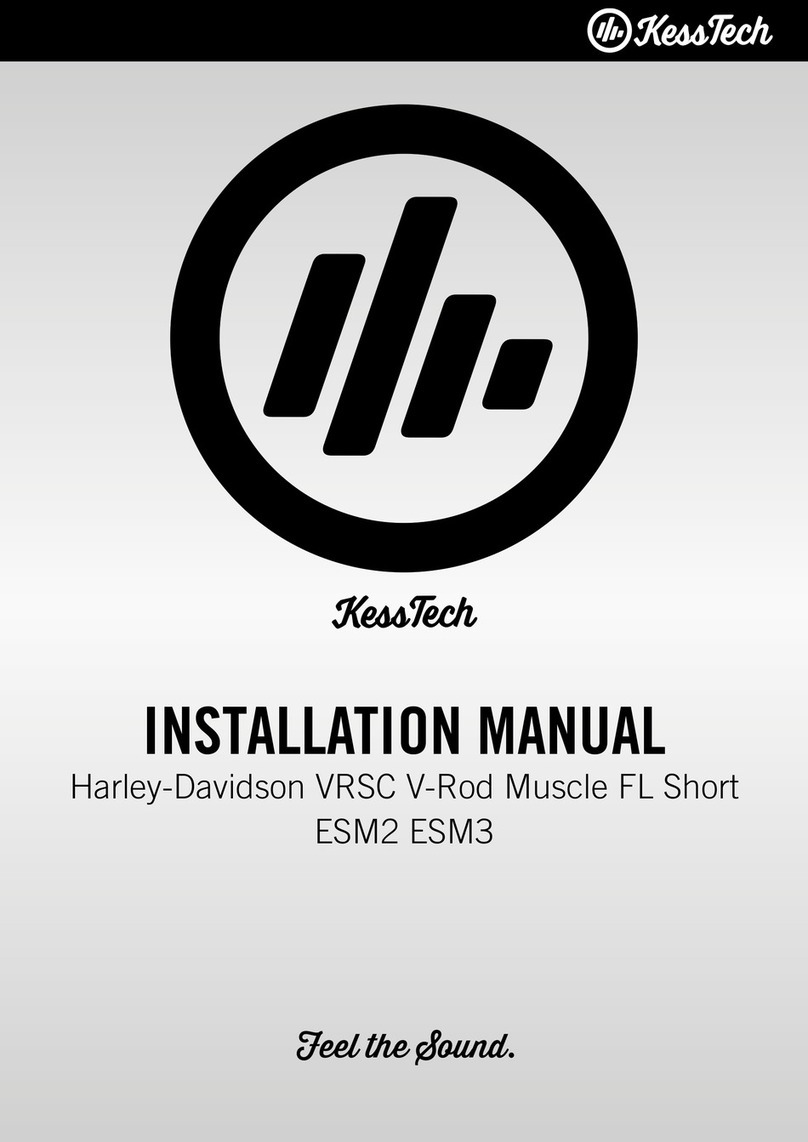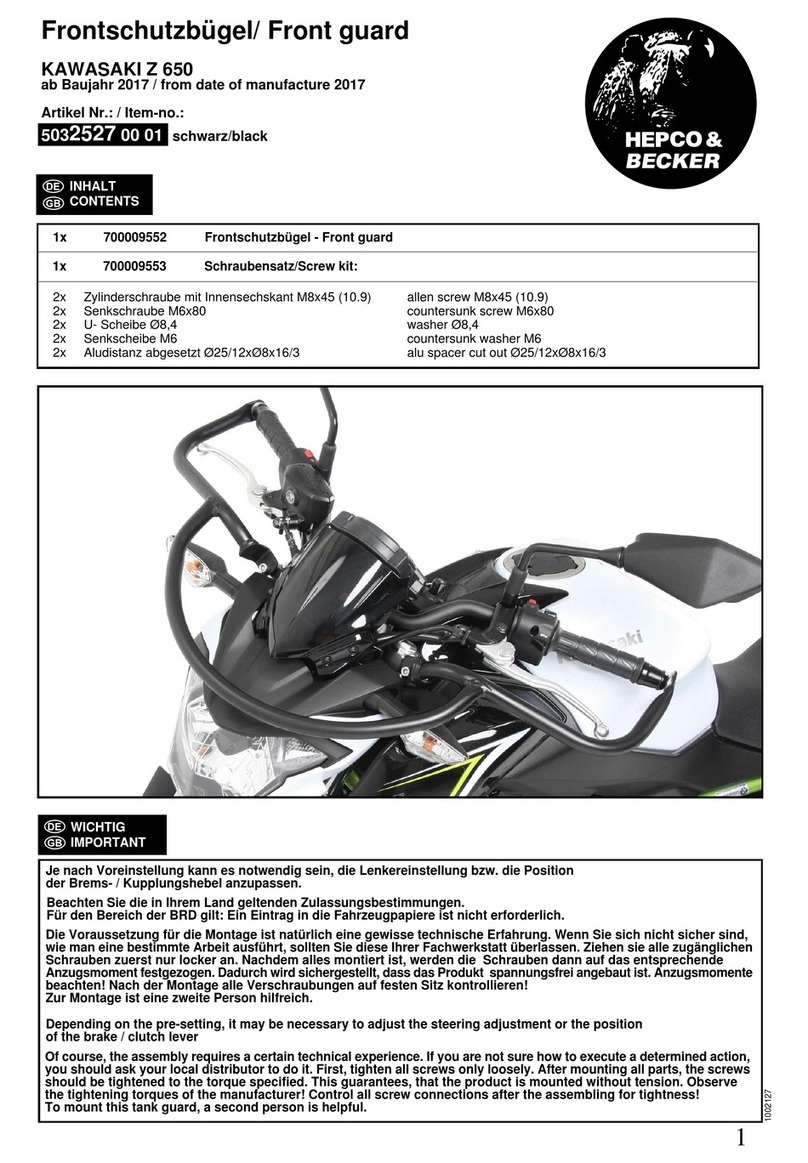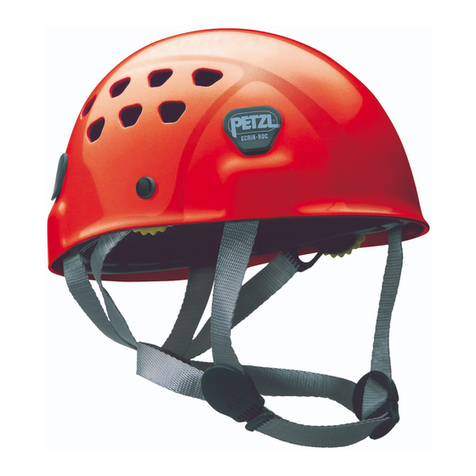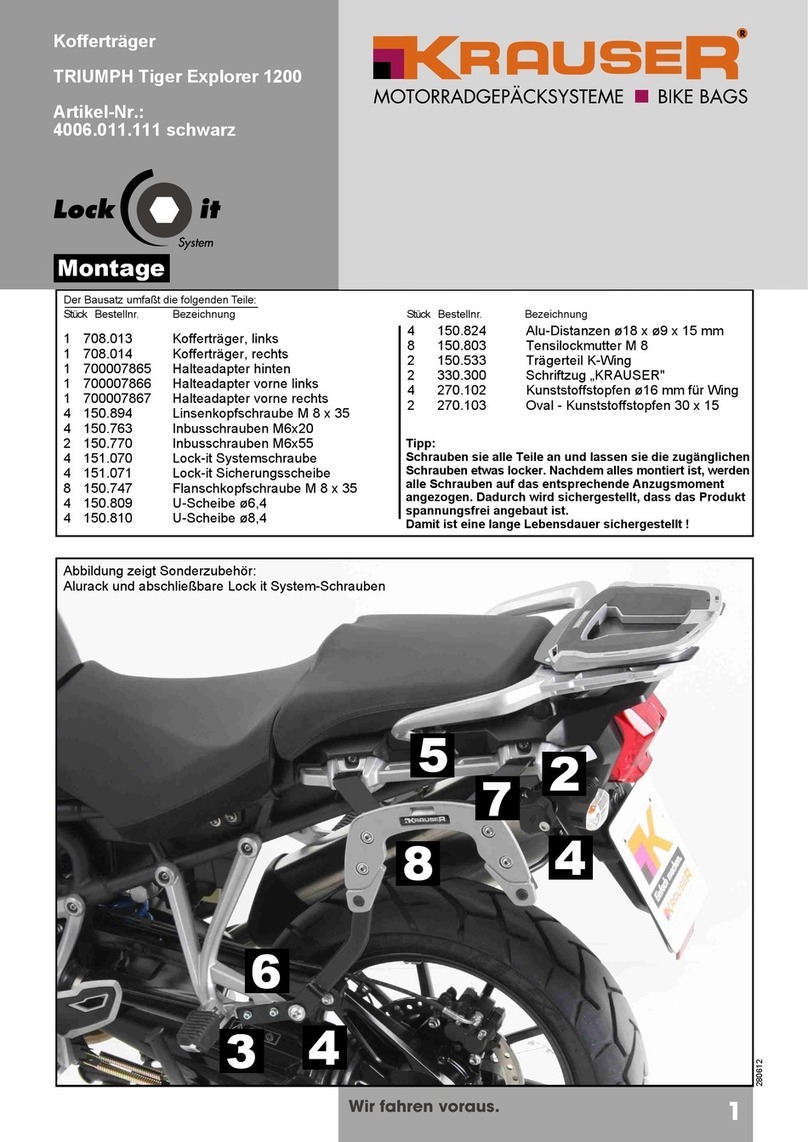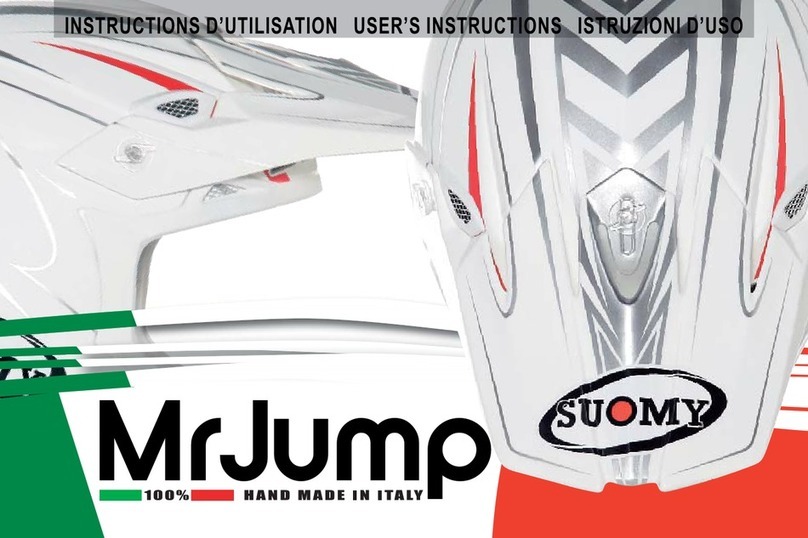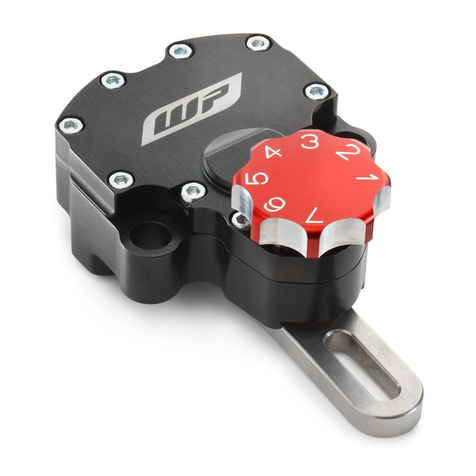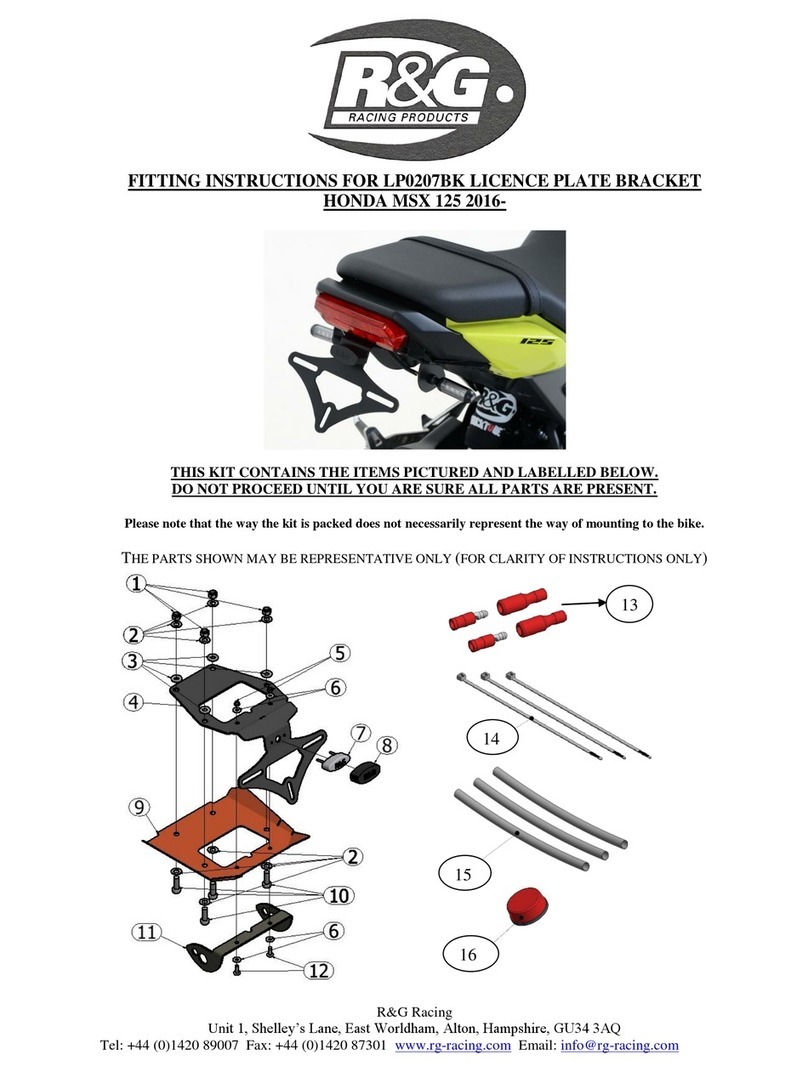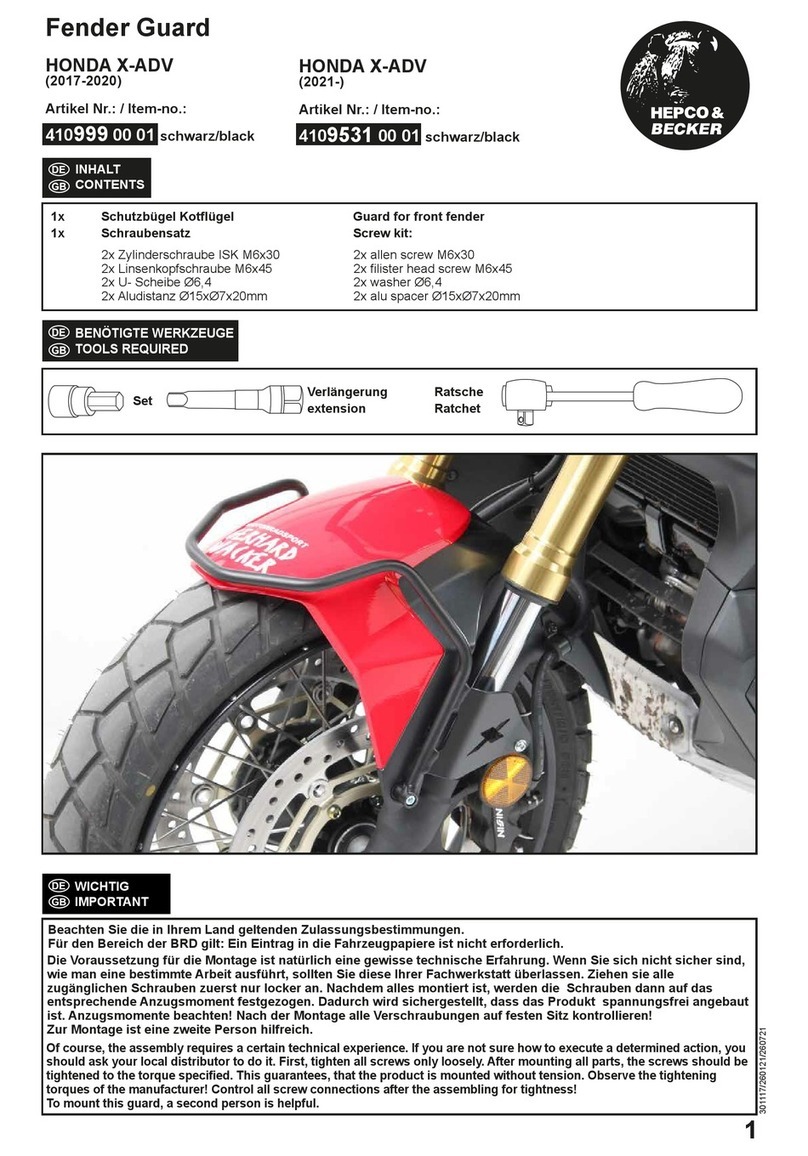TSG WINTER HELMET User manual

WINTER HELMET
USER MANUAL

Supporting the sport is our obsession. Protecting the rider our top priority.
Looking for innovation and leadership our passion. This is why all TSG safety
gear is not only designed and tested by our team riders for its usability and
protective quality but is also tested and certified by official laboratories.
HTTP://RIDETSG.COM
DESIGNED IN SWITZERLAND // MADE IN CHINA

CONTENT
CONTENT
HELMET MANUAL – ENGLISH 002
BENUTZERHANDBUCH – DEUTSCH 007
MANUAL DEL CASCO – ESPAÑOL 013
MANUEL D‘UTILISATION – FRANÇAIS 019
MANUALE D‘ISTRUZIONI – ITALIANO 024
HANDLEIDING HELM – NEDERLANDS 029
NÁVOD K POUŽITÍ – ČESKY 034
INSTRUKCJA OBSŁUGI KASKU – POLSKI 039
РУКОВОДСТВО ПО ЭКСПЛУАТАЦИИ ШЛЕМА – РУССКИЙ 044
헬멧 설명서 – KOREAN 050
HELMET PADS SIZING OVERVIEW 056
HELMET SIZING CHART 057

002 – ENGLISH
ENGLISH
HELMET MANUAL
Thank you. You have chosen a TSG safety product designed especially for
snowboarders and skiers. All TSG helmets are developed with the input of
our professional athletes. Correctly used and cared for, they will keep you
better protected and reassured for many years to come.
APPLICATIONS
TSG snow helmets are designed for all the various forms of snowboarding
and alpine skiing. All TSG helmets fully comply with international safety
regulations.
SAFETY STANDARDS
TSG helmets fulll the requirements and safety regulations stipulated in
EU directive 89/686/EEC. If your helmet bears a CE designation, it meets
the essential safety requirements of EN 1077, class A or B. Class A and
B helmets are for alpine skiers, snowboarders and similar groups. Class
A helmets offer comparatively more protection. Class B helmets may offer
greater ventilation and better hearing, but protect a smaller area of the head
and give a lesser degree of protection from penetration. If your helmet bears
an ASTM designation, it meets the essential safety requirements of F2040.
There must be a clearly visible marking on every approved helmet and this
may not be removed. All TSG helmet models are tested and homologated by
Critt Sport Loisirs, Zone du Sanital, 86100 Chatellerault, France, NB n°0501
and by an accredited testing laboratory in the USA.
WARNING
For use in non-motorized recreational snow sports such as snowboarding,
skiing and other alpine sports only. This helmet should not be used by children
while climbing or doing other activities when there is a risk of strangulation/
hanging if the child gets trapped with the helmet. It is important that the helmet
ts your head properly and that it is correctly buckled. While no helmet can
prevent all head injuries, use of a helmet, taking lessons, riding responsibly
and within your abilities, and common sense, can together signicantly
reduce the risk of catastrophic head injury and death. However, accidents,
serious injuries or death can occur even if the helmet is properly used.
TSG makes no claim that this helmet will eliminate all possibilities of injury.
This helmet is designed to absorb shock by partial destruction of the energy
absorbing liner. This damage may not be visible to the user. Therefore, if
subjected to a severe impact or blow, the helmet should be destroyed and
replaced even if it appears undamaged. A helmet can only provide a level
of protection for areas that it covers. It does not protect your neck. Do not

ENGLISH
ENGLISH – 003
make any attachments to this helmet, other than those recommended by
the manufacturer. Doing so voids all TSG warranties. The helmet may be
damaged by paints, solvent, bleaches or strong detergents, sometimes
invisibly.
FITTING INSTRUCTIONS
To attain maximum protection and comfort, choose the correct helmet size.
It should sit rmly without pressing or chang. It is important that the helmet
can neither ride up your forehead nor be pushed down over your eyes.
PLEASE CONSIDER THE FOLLOWING GUIDELINES FOR A
PROPER FIT OF THE HELMET.
1. Put on the helmet in a manner so that it sits straight on your head and co-
vers your forehead, without blocking your vision. The helmet should t
comfortably; so that it holds onto your head as you move it front and back,
as well as side-to-side.
2. The comfort pads inside the helmet should exert rm, even, but
comfortable pressure against your head. The helmet ts well if the pads are
in contact with all sides of your head around the helmets interior. A helmet
that ts well also ts comfortably without being too tight.
3. When you are satised with the t, tighten the chin strap so it ts snug and
make sure the buckle locks securely and that the straps do not slip. If your
straps aren’t adjusted right, your helmet won’t stay on properly. The loose
ends of the strap must loop back up through the rubber „0“ ring.
4. To adjust the position of the straps, hold one end of the chin buckle in one
hand and slide the adjuster up or down the strap as necessary, to create a
balanced and even „Y“ shape underneath the ears. Position the buckle away
from your jaw bone. It should not be possible to remove the helmet without
opening the chin strap. If you can roll the helmet off in front or back, or roll it
so it blocks your vision or exposes your forehead, it does not t correctly and
should be re-adjusted.
CORRECT
INCORRECT
Blocked
Vision
INCORRECT
Exposed
Forehead

004 – ENGLISH
ENGLISH
HOW TO CUSTOMIZE YOUR FIT
Our Tuned Fit System allows you to dial in your t using different thickness
comfort pads on the interior of the helmet. Your helmet comes with two sizes
of comfort pads. Carefully separate the Velcro strips at room temperature to
remove the pads on the inside of the helmet and swap them for the thickness
you need. Your helmet package contains spare fastening points in case one
of the Velcro fastening points becomes detached. If the helmet still does not
t after having adjusted it with the pads, choose another size. Comfort pads
can be purchased separately in all the various sizes.
HELMETS WITH FLEXTECH INNER-SHELL
If you have purchased a TSG helmet with FlexTech Technology, you will
note the inner shell of your helmet consists of several EPS foam segments
which are connected with a strong nylon webbing tape. These individual
segments are slightly adjustable and therefore adapt perfectly to your head
shape. Our FlexTech Technology increases comfort, whilst completely
fullling all legal norms regarding design and impact protection.
HELMETS WITH DIAL-FIT SYSTEM
If you have purchased a TSG helmet with Dial-Fit System, you can size adjust
your helmet by dial. To tighten the dial, turn it clockwise to a comfortable t.
To loosen, turn the dial counterclockwise. The t should be snug, but not
uncomfortably tight. Be sure to check the adjustment of your helmet before
each ride. The Dial Fit System is designed to enhance the t and stability of
your helmet. It is not a replacement for your helmet’s straps. Do not attempt
to remove the t system from your helmet; doing so will void all of the helmet’s
warranties.
HOW TO REMOVE YOUR EARPADS
You can easily turn your helmet from winter into spring modus by removing
the earpads. Just open the snap-fasteners and pull the straps out through
the loops on the earpads. Detach the neckroll by carefully pulling the pins
out of the EPS foam. Then carefully pull earpads straight up and out from
the helmet shell. Reinstall by pushing the earpad into the slot between shell
and foam and click the neckroll pins back into the embedded holes of the
foam. The soft side of the earpad should face inward, and the neckroll should
run along the back of the helmet. Then install the left side earpad, thread
the helmet’s straps back trough the earpads strap loops and close all snap-
fasteners.
For our light inmold helmet models carefully remove the earpads (attached to
the helmets with snaps) one at a time by gripping them and pressing them out

ENGLISH
ENGLISH – 005
toward the center of the helmet. Carefully detach the neckroll by pulling the
pins out of the foam. To reinstall, push the earpad’s pins into the snap basket
on the inside of the helmet, click the neckroll pins into the holes of the foam
and repeat process with the other earpad.
MATERIALS
TSG helmets are made of high-tech materials for optimal functionality. Our
durable hard shell helmets are made of ABS, PC or PP plastic, depending
of your helmet model. Our super light In-mold helmets use a thin in-mold PC
shell. All helmets use a core of impact absorbing EPS. In-mold helmets are
generally a little more susceptible to pressure than hard shell helmets, but
boast the same cushioning properties in line with the relevant CE standard.
CARE
Do not expose your helmet to impact or external force during transport. Store
it in a dry place away from any source of heat like a hot radiator or sunshine
through a car window. If your helmet melts it is not covered by our warranty.
Clean your helmet with a damp cloth and perhaps a little mild liquid soap. Do
not use strong detergent or solvents. Decal, glue etc. may reduce durability.
Your helmet comfort pads are removable and should be washed by hand in
a bucket with mild soap and water, rinsed and then air dried only. Helmets
have a limited life span in use and should be replaced after three years of
use. If you know or suspect that your helmet has been damaged or exposed
to any abnormal force, you should have it carefully checked by an authorized
TSG dealer. Damage that may reduce your helmet’s protective qualities can
be invisible and difcult to detect. Replace the helmet if there is any sign or
suspicion of damage.
WARRANTY
TSG International AG warrants that this product is free of manufacturing
defects in material and workmanship when it is delivered to our dealers.
Unless otherwise stipulated by local law, this warranty is limited to one
year from the date of purchase and is limited to the original purchaser.
This warranty does not apply in the event of abuse, negligence,
carelessness or modification, or if the product is used in any way other
than is intended. Nor is any attempted repair or replacement with any part
or accessory other than original TSG parts and products covered by the
terms of this warranty. This warranty takes precedence over any other
agreements or warranties, general or special, expresses or implied and
no representative or person is authorized to assume liability on behalf
of TSG in connection with the sale or use of this product. TSG makes
no other expressed warrantees, except as otherwise specifically stated.

TSG waives all responsibility for any third party for consequences
that might result from the use or handling of any TSG product by any
legal or natural person.
HOW TO MAKE A WARRANTY CLAIM
If your TSG helmet is found to be defective in materials or workmanship
TSG warrants your helmet for one year from the date of purchase and we
will, at our sole option, either repair or replace your helmet free of charge.
Just take your helmet to the dealer from which it was purchased, with a
letter indicating the specic reason you’re returning the helmet, and proof
of purchase. The dealer will then evaluate the claim.
FOR MORE INFORMATION CONTACT US AT
INFO@RIDETSG.COM
TSG INTERNATIONAL AG
BÜLACHSTRASSE 5
8057 ZÜRICH, SWITZERLAND HTTP://RIDETSG.COM
006 – ENGLISH
ENGLISH

DEUTSCH
DEUTSCH – 007
BENUTZERHANDBUCH
Vielen Dank, dass Sie sich für ein auf Snowboarder und Skifahrer
zugeschnittenes Sicherheitsprodukt aus dem Hause TSG entschieden
haben. Alle TSG Helme wurden in Zusammenarbeit mit Profi-Sportlern
entwickelt. Bei korrekter Anwendung und Pflege bietet Ihnen dieses
Produkt viele Jahre lang optimalen Schutz.
ANWENDUNGSBEREICHE
Die Wintersporthelme von TSG sind für den Einsatz beim Alpinskifahren
und Snowboarden konzipiert. Alle TSG Helme entsprechen vollständig den
internationalen Sicherheitsbestimmungen.
SICHERHEITSBESTIMMUNGEN
Die Helme von TSG entsprechen den in den EU-Richtlinien 89/686/EEC
festgelegten Anforderungen und Sicherheitsbestimmungen. Verfügt Ihr
Helm über eine CE-Kennzeichnung, entspricht er den erforderlichen EN
1077 Sicherheitsbestimmungen für die Klassizierung A oder B. Helme
der Klassizierung A und B wurden für den Einsatz beim Alpinskifahren,
Snowboarden und bei ähnlichen Wintersportarten entwickelt. Klasse-A-
Helme bieten vergleichsweise höheren Schutz. Klasse-B-Helme verfügen
gemeinhin über etwas bessere Ventilation und ermöglichen besseres
Hören; sie decken jedoch weniger Fläche am Kopf ab und schützen
so etwas weniger gut vor eindringenden Gegenständen. Verfügt der
Helm über eine ASTM-Kennzeichnung, entspricht er den erforderlichen
F2040 Sicherheitsbestimmungen. Die Kennzeichnung muss auf jedem
zugelassenen Helm klar und deutlich sichtbar sein und darf nicht entfernt
werden. Alle TSG Helmmodelle wurden von Critt Sport Loisirs, Zone du
Sanital, 86100 Chatellerault, Frankreich, NB n°0501 und einem autorisierten
Testlabor in den USA getestet und zugelassen.
ACHTUNG
Die Helme sind ausschließlich für den Einsatz im nicht motorisierten
Wintersport, wie zum Beispiel beim Snowboarden, Skifahren und weiteren
Alpinsportarten, geeignet. Dieser Helm sollte nicht durch Kinder beim Klettern
oder anderen Aktivitäten verwendet werden, wenn ein Risiko besteht, sich zu
strangulieren/hängen zu bleiben, falls sich das Kind mit dem Helm verfängt.
Der Helm muss unbedingt einwandfrei passen, überall am Kopf gut anliegen
und per Kinnriemen ordnungsgemäß xiert werden. Während kein Helm
der Welt alle Kopfverletzungen verhindern kann, können das Tragen eines
Helms sowie Snowboard- und Ski-Unterricht, verantwortungsbewusstes
und dem Können angepasstes Fahren und gesunder Menschenverstand

008 – DEUTSCH
DEUTSCH
zusammen das Risiko folgenschwerer oder gar tödlicher Kopfverletzungen
maßgeblich verringern. TSG erhebt keinen Anspruch darauf, dass dieser
Helm alle Verletzungen verhindert. Dieser Helm absorbiert Schläge und
Stöße durch die teilweise Zerstörung des stoßdämpfenden Einsatzes. Diese
Schäden sind bisweilen schwer zu erkennen oder gar unsichtbar. Deshalb
sollte ein Helm nach einem schweren Sturz oder Aufprall entsorgt und
ersetzt werden, selbst wenn er intakt und unversehrt erscheint. Ein Helm
bietet lediglich für die Bereiche des Kopfes einen gewissen Schutz, die er
auch abdeckt. Er schützt nicht den Hals und Nacken. Bringen Sie keine
Gegenstände am Helm an, außer die, die vom Hersteller empfohlen wurden.
Durch gegensätzliche Handlungen verliert die Garantie seitens TSG ihre
Gültigkeit. Der Helm könnte durch Farbe, Lösungsmittel, Bleichmittel oder
starke Reinigungsmittel beschädigt sein, auch wenn dies optisch nicht zu
erkennen ist.
ANPASSEN DES HELMS
Um maximalen Schutz und Komfort zu gewährleisten, ist die Auswahl
der richtigen Helmgröße von entscheidender Bedeutung. Der Helm sollte
gut und fest auf dem Kopf sitzen, ohne zu drücken oder scheuern. Es ist
wichtig, dass der Helm weder nach oben über die Stirn noch nach vorne
über die Augen rutscht.
BITTE BEACHTEN SIE DIE FOLGENDEN EMPFEHLUNGEN
FÜR EINEN PERFEKTEN SITZ DES HELMS:
1. Setzen Sie den Helm so auf, dass er gerade auf dem Kopf sitzt und die
Stirn bedeckt, ohne die Sicht zu beeinträchtigen. Der Helm sollte bequem
passen, so dass er selbst dann auf Position bleibt, wenn Sie den Kopf nach
vorne und hinten sowie zur Seite neigen.
2. Die Komfort-Pads im Inneren des Helms sollten einen festen,
gleichmäßigen, aber bequemen Druck auf den Kopf ausüben. Der Helm
passt gut, wenn die Pads auf der Innenseite des Helms überall gleichmäßig
am Kopf anliegen. Ein Helm, der gut passt, sitzt bequem, ohne einzuengen.
3. Wenn Sie mit dem Sitz des Helms zufrieden sind, ziehen Sie den Kinnriemen
fest und stellen Sie sicher, dass die Kunststoffschließe fest und sicher
geschlossen ist und die Riemen nicht verrutschen können. Sind die Riemen
nicht korrekt eingestellt, bleibt der Helm nicht auf Position. Die losen Enden
der Riemen werden durch den „0“-förmigen Gummiring nach hinten gezogen.

DEUTSCH
DEUTSCH – 009
4. Um die Riemen korrekt einzustellen, halten Sie ein Ende der
Kunststoffschließe am Kinn in einer Hand und verschieben Sie den Justierer
am Riemen entsprechend nach oben oder unten, so dass eine gleich-
mäßige „Y“-Form unterhalb der Ohren erreicht wird. Achten Sie darauf, dass
der Verschluss nicht auf dem Kieferknochen aufliegt. Der Helm soll sich nicht
absetzen lassen, ohne dass man den Kinnriemen öffnet. Lässt sich der Helm
nach vorne oder hinten vom Kopf schieben oder so verschieben, dass er
die Sicht versperrt oder die Stirn freilegt, passt er nicht richtig und sollte
neu eingestellt werden.
INDIVIDUELLE ANPASSUNG DER PASSFORM
Das Tuned Fit System von TSG ermöglicht eine individuelle Anpassung der
Passform dank unterschiedlich dicker Komfort-Pads im Inneren des Helms.
Der Helm wird mit Komfort-Pads in zwei verschiedenen Größen geliefert.
Trennen Sie die per Klettverschluss im Helm befestigten Pads vorsichtig bei
Raumtemperatur ab und tauschen Sie diese je nach Belieben durch Komfort-
Pads in der gewünschten Größe aus. Sollte sich dennoch ein Klettklebepunkt
lösen, nden Sie Ersatzklebepunkte in Ihrer Helmverpackung. Sollte der
Helm nach der Anpassung der Pads immer noch nicht richtig passen, wählen
Sie eine andere Größe. Komfort-Pads in den verschiedenen Grössen sind
einzeln erhältlich.
HELME MIT FLEXTECH INNENSCHALE
Sollten Sie einen TSG Helm mit FlexTech Technologie erworben haben,
dann besteht die Innenschale aus mehreren EPS Schaum Segmenten,
die durch ein verstärktes Nylonband miteinander verbunden sind. Die
einzelnen Schaumsegmente sind minimal beweglich und können sich
somit perfekt an Ihre Kopfform anpassen. Unsere FlexTech Technologie
steigert den Tragekomfort während Ihr Helm gleichzeitig die gesetzlichen
Normen bezüglich Design und Aufprallschutz voll und ganz erfüllt.
RICHTIG
FALSCH
Blockierte
Sicht
FALSCH
Freiliegende
Stirn

010 – DEUTSCH
DEUTSCH
HELME MIT DIAL-FIT SYSTEM
Sollten Sie einen Helm mit Dial-Fit System erworben haben, dann können
Sie die Größe per Verstellrad anpassen. Um das Dial Fit System straffer
zu stellen, drehen Sie das Verstellrad im Uhrzeigersinn. Um das System
zu lockern, drehen Sie das Verstellrad gegen den Uhrzeigersinn. Der Sitz
sollte fest, aber nicht unangenehm fest sitzen. Prüfen Sie vor jeder Fahrt die
Einstellung Ihres Helms. Das Dial Fit System soll die Passform und Stabilität
Ihres Helms verbessern. Sie sind kein Ersatz für die Riemen Ihres Helms.
Versuchen Sie nicht, dass Passsystem vom Helm zu trennen. Geschieht dies
dennoch, erlöschen alle Garantien für den Helm.
ENTFERNEN DER OHRENPOLSTER
Bei diesem Helm kann man ganz einfach vom Winter- in den Sommermodus
wechseln, indem man die Ohrenpolster entfernt. Lösen Sie dazu die
Druckknöpfe und ziehen Sie die Straps durch die Schlaufen an den
Ohrenpolstern heraus. Das Nackenpolster wird durch vorsichtiges
Herausziehen der Kunststoffstifte aus dem EPS Schaum gelöst. Ziehen Sie
dann die Ohrenpolster vorsichtig gerade nach oben und aus der Helmschale
heraus. Zum Wiederanbringen drücken Sie das rechte Ohrenpolster in den
Schlitz zwischen Helmschale und Schaumstoff und klicken die Kunststoffstifte
des Nackenpolsters in die eingelassenen Löcher des Schaums. Die weiche
Seite der Ohrenpolster zeigt nach innen und das Nackenpolster bendet sich
auf der Rückseite des Helms. Bringen Sie dann das linke Ohrenpolster an,
fädeln Sie die Riemen des Helms durch die Schlaufen der Ohrenpolster und
schließen Sie alle Druckknöpfe.
Bei unseren leichten Inmold Modellen entfernt man die Ohrnepolster
(die per Klick-System am Helm angebracht sind) einzeln, indem man
sie zur Mitte des Helms hin herausdrückt. Das Nackenpolster wird durch
vorsichtiges Herausziehen der Kunststoffstifte aus dem EPS Schaum
gelöst. Zum Wiederanbringen drücken Sie die Kunststoffstifte wieder
in die Einrastvorrichtung auf der Innenseite des Helms, klicken Sie das
Nackenpolster in die dafür vorgesehenen Löcher des hinteren Schaums und
wiederholen diesen Vorgang beim anderen Ohrenpolster.

DEUTSCH
DEUTSCH – 011
MATERIALIEN
Für die Helme von TSG kommen ausschließlich High-Tech-Materialien für
höchstmögliche Funktionalität zum Einsatz. Die robusten Hartschalenhelme
von TSG bestehen aus ABS-, PC- oder PP-Kunststoff, während die extrem
leichten In-Mold-Helme über eine dünne In-Mold-PC-Schale verfügen.
Allen Helmen gemein ist ein stoßdämpfender EPS-Kern. In-Mold Helme
sind generell druckempndlicher als Hartschalenhelme, verfügen aber über
gleichwertige Dämpfungseigenschaften mit entsprechender CE-Norm.
PFLEGE
Schützen Sie den Helm während des Transports vor Stößen und
Beschädigungen. Bewahren Sie den Helm trocken auf und setzen Sie ihn
nicht starker Hitze aus, wie sie hinter der Windschutzscheibe im Auto oder
in der Nähe von Heizkörpern auftritt. Schmilzt Ihr Helm, so wird dies nicht
durch unsere einjährige Garantie abgedeckt. Den Helm mit einem feuchten
Tuch und bei Bedarf mit einer leichten Seifenlösung reinigen. Keine starken
Reinigungs- oder Lösungsmittel verwenden. Aufkleber, Klebstoffe u. ä. können
die Haltbarkeit beeinträchtigen. Die Helm-Innenpolster sind herausnehmbar
und sollten mit der Hand in Wasser mit milder Seife gewaschen werden.
Nach der Reinigung gut ausspülen und an der Luft trocknen lassen.
Die Haltbarkeit eines Helmes ist begrenzt. Nach dreijähriger Nutzung sollte
er gewechselt werden. Wenn Sie wissen oder vermuten, dass der Helm
beschädigt wurde oder schweren Belastungen ausgesetzt war, sollte er von
einem TSG Händler geprüft werden. Schäden, welche die Schutzfunktion
beeinträchtigen, sind manchmal unsichtbar und können schwer festgestellt
werden. Bei Anzeichen oder beim Verdacht auf eine Beschädigung sollte der
Helm ausgewechselt werden.
GARANTIE
TSG International AG garantiert, dass dieses Produkt bei Lieferung an den
Händler keine Fabrikationsfehler oder Materialschäden aufweist. Außer in
den Fällen und an den Orten, wo andere gesetzliche Regelungen gelten,
gilt diese Garantie für den Erstkäufer ein Jahr ab Kauf. Die Garantie gilt
nicht bei Nachlässigkeit, Unvorsichtigkeit, Veränderungen oder Nutzung
in anderen Situationen als den vorgesehenen. Die Garantieleistung ist
ebenfalls ausgeschlossen bei eigenen Reparaturversuchen sowie in
Kombination mit Teilen oder Zubehör anderer Hersteller als TSG. Diese
Garantie hat Vorrang vor eventuellen anderen, direkten oder indirekten
Vereinbarungen. TSG übernimmt keine Haftung gegenüber Dritten, die
sich aus der Anwendung oder Handhabung eines TSG Produkts durch
juristische oder natürliche Personen ergibt.

012 – DEUTSCH
DEUTSCH
ERHEBUNG EINES GARANTIEANSPRUCHS
Weist Ihr TSG Helm einen Fehler oder Defekt bei Material oder Verarbeitung
auf, gewährt Ihnen TSG eine einjährige Garantie ab Kaufdatum. TSG wird
den Helm dann auf eigenen Wunsch entweder kostenfrei reparieren oder
ersetzen. Bringen Sie den Helm einfach zu dem Verkäufer, bei dem Sie ihn
erworben haben, und legen den Kaufbeleg sowie eine schriftliche Erklärung
bei, warum Sie den Helm zurückgeben möchten. Ihr Verkäufer wird den
Garantiefall für Sie abwickeln.
WENN SIE WEITERE INFORMATIONEN BENÖTIGEN,
KONTAKTIEREN SIE TSG BITTE ÜBER INFO@RIDETSG.COM
TSG INTERNATIONAL AG
BÜLACHSTRASSE 5
8057 ZÜRICH, SCHWEIZ HTTP://RIDETSG.COM

ESPAÑOL
ESPAÑOL – 013
MANUAL DEL CASCO
Gracias. Ha elegido un producto de seguridad de TSG diseñado
específicamente para snowboarders y esquiadores. Todos los cascos
TSG se desarrollan en colaboración con deportistas profesionales. Si
lo usa y cuida correctamente, disfrutará durante años de una mayor
protección y satisfacción.
APLICACIONES
Los cascos para nieve de TSG están diseñados para cualquier modalidad de
snowboard y esquí alpino. Todos los cascos de TSG cumplen rigurosamente
con todas las normas internacionales sobre seguridad.
ESTÁNDARES DE SEGURIDAD
Los cascos TSG cumplen los requisitos y normas de seguridad establecidos
en la Directiva 89/686/CEE de la Unión Europea. Si su casco porta la
identicación CE, entonces cumple con los requisitos fundamentales de
seguridad de EN 1077, clase A o B. Los cascos de la clase A y B están
diseñados para esquiadores alpinos, snowboarders y grupos similares. Los
cascos de la clase A ofrecen, en comparación, una mayor protección. Los
cascos de la clase B pueden ofrecer una mayor ventilación y una mejor
audición, pero protegen una menor área de la cabeza y ofrecen un menor
grado de protección a la penetración. Si su casco porta la identicación
ASTM, entonces cumple con los requisitos fundamentales de seguridad de
F2040. Cada casco homologado debe portar una marca bien visible que
no puede ser retirada. Todos los modelos de casco TSG están testados y
homologados por Critt Sport Loisirs, Zone du Sanital, F-86100 Chatellerault,
NB n°0501 y por un laboratorio de pruebas acreditado en los EE. UU.
ADVERTENCIA
Para actividades deportivas recreativas sobre nieve y no motorizadas,
como el snowboard, el esquí y otros deportes alpinos únicamente. No
es aconsejable que los niños utilicen este casco para realizar escalada u
otras actividades que presenten un riesgo de estrangulamiento en caso de
quedar enganchados por el casco. Es importante que el casco se ajuste
debidamente a su cabeza y que esté correctamente abrochado. Si bien
ningún casco puede evitar todo tipo de lesiones en la cabeza, el uso de un
casco, el aprendizaje, la práctica responsable y prudente del ejercicio y el
sentido común pueden reducir mucho el riesgo de grave lesión en la cabeza
o de muerte. No obstante, pueden ocurrir accidentes, graves lesiones o la
muerte incluso con un uso correcto del casco. TSG no garantiza que este
casco elimine cualquier posibilidad de lesión. El casco está diseñado para

014 – ESPAÑOL
ESPAÑOL
absorber el choque mediante destrucción parcial del forro antiimpacto.
El daño puede no resultar visible al usuario. Por lo tanto, si el casco ha
sufrido un fuerte impacto o golpe, hay que eliminarlo o reemplazarlo, aunque
parezca que no ha sufrido daños. Un casco proporciona cierta protección
sólo a las áreas que cubre. Éste no protege su cuello. No añada al casco
ningún accesorio que no esté recomendado por su fabricante. Si lo hace
dejará sin efecto cualquier garantía de TSG. El casco puede sufrir daños,
a veces no visibles, a causa de pinturas, disolventes, lejías o detergentes
fuertes.
INSTRUCCIONES DE AJUSTE
Para conseguir la máxima protección y confort, escoja un casco de su talla.
El casco debe ajustarse bien, sin presiones ni rozaduras. Es importante
que el casco no pueda deslizarse, dejando al descubierto su frente, ni caer
sobre sus ojos.
POR FAVOR, PARA UN CORRECTO AJUSTE DEL CASCO
TENGA EN CUENTA LO SIGUIENTE.
1. Póngase el casco de modo que éste apoye recto sobre su cabeza y cubra
su frente, sin impedirle la visión. El casco debe ajustar con comodidad, de
modo que quede bien sujeto en su cabeza cuando la mueva hacia delante o
hacia atrás o a los lados.
2. Las almohadillas de confort interiores del casco deben ejercer una
presión rme, uniforme, pero confortable, contra su cabeza. El casco está
bien ajustado si las almohadillas interiores del casco están en contacto con
todos los lados de su cabeza. Un casco que ajusta bien también ajusta con
comodidad sin apretar demasiado.
3. Cuando quede satisfecho con el ajuste, cíñase la correa de barbilla de
modo que ajuste cómodamente y compruebe que la hebilla cierra bien y los
tirantes no se mueven. Si los tirantes no ajustan debidamente, su casco no
está bien puesto. Los extremos sueltos del tirante deben hacerse pasar por
el anillo de goma “0”.
4. Para ajustar la posición de los tirantes, sujete con una mano un extremo
de la hebilla de barbilla y deslice el ajustador según sea preciso, hacia arriba
o abajo, para conseguir una equilibrada y uniforme forma de “Y” por debajo
de las orejas. Aparte la hebilla de la mandibula. Debe resultar imposible
quitarse el casco sin abrir la correa de la barbilla. Si puede deslizar el casco
hacia adelante o hacia atrás, o de modo que impida su visión o exponga su
frente, entonces es que éste no ajusta bien y debe reajustarlo.

ESPAÑOL
ESPAÑOL – 015
CÓMO PERSONALIZAR SU AJUSTE
Nuestro Tuned Fit System (Sistema de Ajuste Fino) le permite regular su
ajuste usando almohadillas de confort de diferente grosor en el interior
del casco. Su casco viene con almohadillas de confort de dos tamaños. A
temperatura ambiente, separe cuidadosamente las almohadillas jadas al
casco mediante un velcro y cámbielas por las almohadillas de confort del
tamaño adecuado. Si aún así se sigue soltando algún cierre de velcro,
encontrará cierres adicionales en el embalaje de su casco.
Si el casco sigue sin quedar bien después del ajuste con las almohadillas,
elija otro tamaño. Las almohadillas de confort en los distintos tamaños están
disponibles por separado.
CASCOS CON CALOTA INTERIOR FLEXTECH
Si ha comprado un casco TSG dotado de tecnología FlexTech, la calota
interior está compuesta por varias láminas de espuma EPS conectadas
por medio de una cinta de malla de nailon muy resistente. Los segmentos
individuales tienen cierta movilidad, de manera que se adaptan a la
perfección a la silueta del cráneo. Nuestra tecnología FlexTech aporta más
confort al tiempo que cumple rigurosamente todas las normativas legales
relativas al diseño y la protección contra impactos.
CASCOS CON SISTEMA DE AJUSTE POR DIAL FIT
Si has comprado un casco TSG con regulación Dial Fit System, puedes
ajustar la talla con el dial. Para apretar el dial, girarlo en el sentido de las
agujas de un reloj hasta conseguir un porte confortable. Para aojar el ajuste
girar el dial en el sentido contrario de las agujas de un reloj. Asegúrate de
comprobar el ajuste de tu casco antes de cada ride. El sistema Dial Fit
System ha sido diseñado para mejorar el ajuste y la estabilidad de tu casco.
En ningún caso deberá usarse como reemplazo de las correas del casco. No
trates de quitar el sistema de ajuste del casco; el hacerlo anularía todas las
garantías del casco.
CORRECTO
INCORRECTO
Visión
bloqueada
INCORRECTO
Frente
descubierta

016 – ESPAÑOL
ESPAÑOL
CÓMO QUITAR LAS ALMOHADILLAS DE OREJA
Quitando las almohadillas de oreja puede recongurar fácilmente su casco
de modo invierno a modo primavera. Simplemente abra los broches de
presión y saque los tirantes por las presillas que hay sobre las almohadillas
de las orejas. Desenganche con cuidado la nuquera soltando los pines de
la espuma EPS. Con cuidado, tire entonces hacia arriba de las almohadillas
de las orejas y sáquelas de la coraza del casco. Reinstale metiendo la
almohadilla en la ranura situada entre la coraza y la espuma y je los pines
de la nuquera en la espuma, en los agujeros destinados. El lado suave de
la almohadilla de oreja debe quedar hacia dentro y la nuquera debe recorrer
la parte trasera del casco. Instale entonces la almohadilla izquierda, pase
otra vez los tirantes del casco por las presillas de las almohadillas de oreja y
cierre todos los broches de presión.
En el caso de nuestros ligeros modelos de casco In-mold, retire con cuidado
las almohadillas de oreja (montadas en el casco mediante un sistema de
clic) sujetándolas y sacándolas hacia el centro del casco. Con cuidado, libere
la nuquera soltando los pines. Para reinstalar, introduzca los pines de la
almohadilla de oreja en la hembrilla de la parte interior del casco, je los
pines de la nuquera en la espuma, en los agujeros destinados y repita el
proceso con la otra almohadilla de oreja.
MATERIALES
Para un óptimo funcionamiento, los cascos TSG están hechos de
materiales de alta tecnología. Nuestros cascos de coraza rígida y duraderos
están hechos de plástico ABS, PC o PP, dependiendo del modelo.
Nuestros cascos ultraligeros In-mold integran una na coraza PC in-mold.
Todos los cascos llevan un núcleo EPS antiimpactos. Los cascos In-mold
son por lo general más sensibles a la presión que los cascos de estructura
robusta, pero poseen idénticas propiedades de amortiguación con la
correspondiente certicación CE.

ESPAÑOL
ESPAÑOL – 017
MANTENIMIENTO
Cuando lo transporte, no exponga su casco a impactos o fuerzas externas.
Guárdelo en un lugar seco, lejos de fuentes de calor, como radiadores o la
luz solar a través de las lunas del coche. Si su casco se derrite, la garantía
no lo cubre. Limpie su casco con un paño húmedo y quizás algo de jabón
líquido suave. No use detergentes o disolventes fuertes. Las calcomanías, el
pegamento, etc., pueden reducir su vida útil.
Las almohadillas de confort de su casco pueden quitarse y deben lavarse a
mano en un cubo con jabón suave y agua, aclararse y dejarse secar únicamente
al aire. Los cascos tienen una vida útil limitada y deben reemplazarse al cabo
de tres años de uso. Si sabe o sospecha que su casco ha quedado dañado o
expuesto a una fuerza anormal, deberá hacer que lo revise minuciosamente
un agente TSG autorizado. Los daños que pueden reducir la capacidad de
protección de su casco pueden resultar invisibles o difíciles de detectar.
Reemplace su casco en caso de indicio o sospecha de daño.
GARANTÍA
TSG International AG garantiza que cuando este producto se envió a
nues-tros distribuidores estaba libre de defectos de fabricación en material
y manufactura. Salvo disposición en contra de la legislación local, esta
garantía se limita a un año desde la fecha de compra y se reere sólo al
comprador originario. La garantía no se aplica en caso de uso indebido,
negligencia, desatención o modicación, o si el producto se usa para
un n distinto del debido. Las condiciones de garantía tampoco cubren
reparaciones o recambios efectuados con piezas o accesorios distintos de
las piezas y productos originales de TSG. Esta garantía prevalece sobre
cualquier otro acuerdo o garantía, general o especial, expresa o implícita,
y nadie, representante o persona en general, está autorizado a asumir
responsabilidades en nombre de TSG en relación con la venta o uso de
este producto. Salvo especíca disposición en otro sentido, TSG no brinda
ninguna otra garantía expresa. TSG no asume responsabilidad alguna de
terceros por las posibles consecuencias resultantes del uso o manejo de un
producto de TSG por persona jurídica o física.

018 – ESPAÑOL
ESPAÑOL
CÓMO RECLAMAR UN DERECHO DE GARANTÍA
De constatarse que su casco TSG presenta defectos en materiales o
manufactura, TSG le garantiza su casco durante un año posterior a la fecha de
compra y, a discreción exclusivamente nuestra, repararemos o sustituiremos
su casco sin coste alguno. Lleve simplemente su casco al distribuidor a
quien se lo compró con una carta que indique la razón especíca por la que
devuelve el casco y el justicante de compra. El distribuidor evaluará en tal
caso su reclamación.
PARA MÁS INFORMACIÓN, PÓNGASE EN CONTACTO CON
NOSOTROS EN INFO@RIDETSG.COM
TSG INTERNATIONAL AG
BÜLACHSTRASSE 5
8057 ZÜRICH, SUIZA HTTP://RIDETSG.COM
Table of contents
Languages:
Popular Motorcycle Accessories manuals by other brands
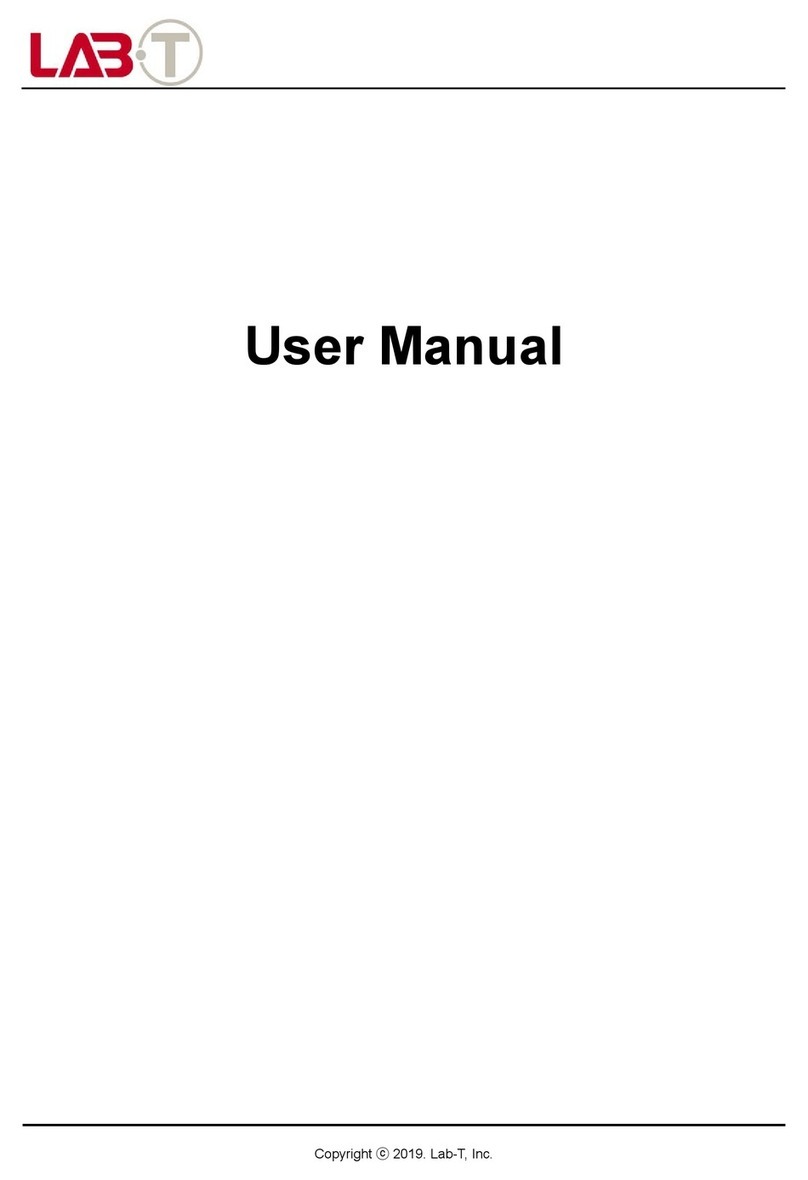
Lab-T
Lab-T R1M user manual
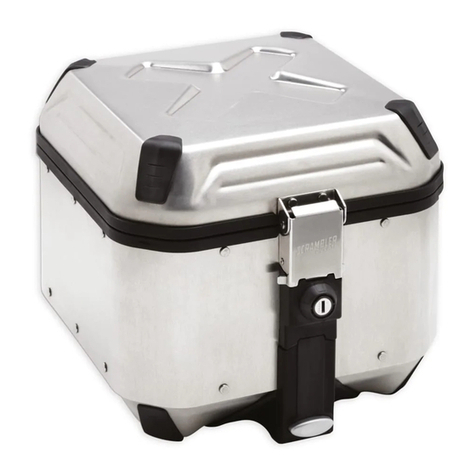
DUCATI Performance
DUCATI Performance 96780551A manual

Parkside
Parkside PSHL 2 A2 Operation and safety notes translation of the original instructions
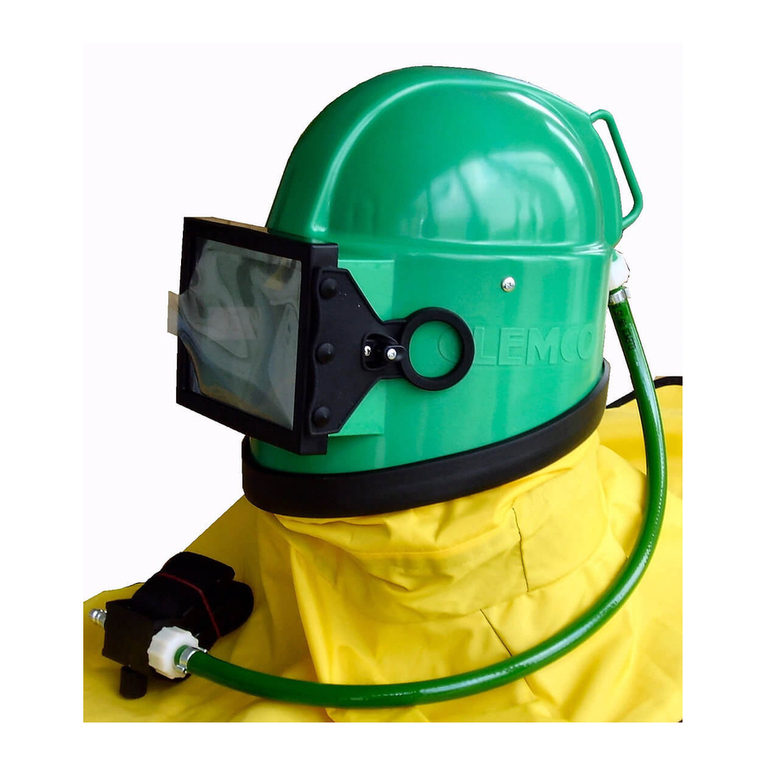
Clemco
Clemco APOLLO 100 CE owner's manual

Arai
Arai Classic-V Operation instructions
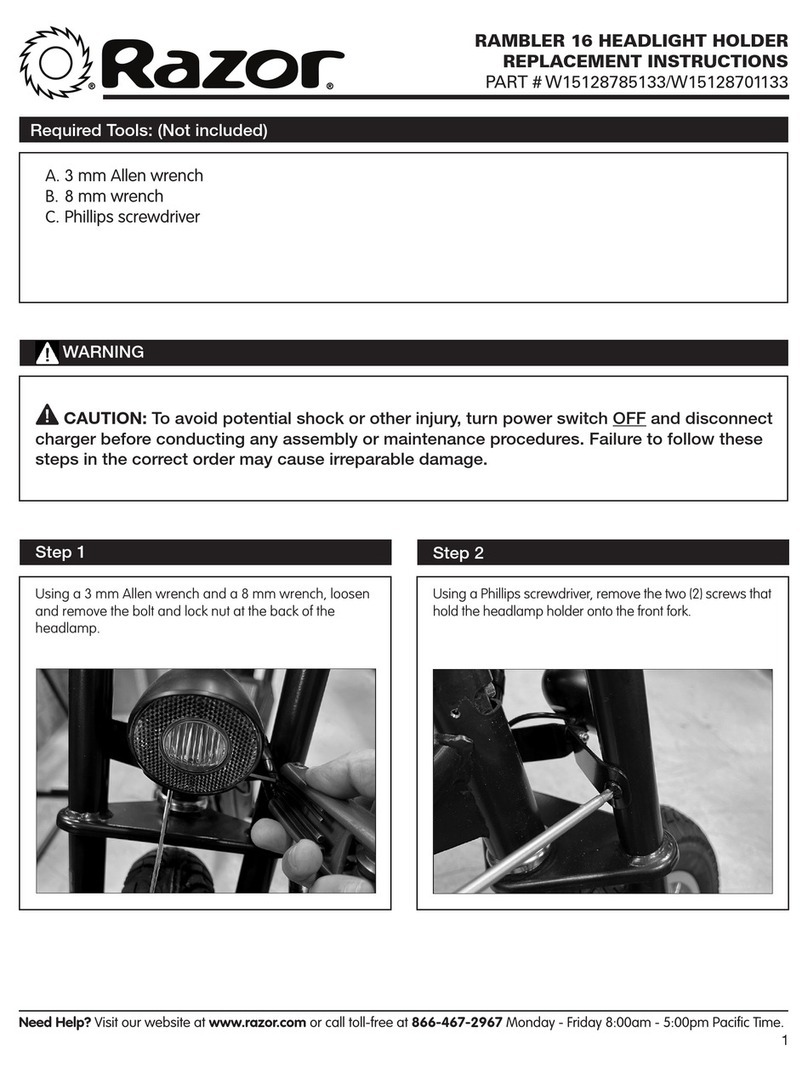
Razor
Razor W15128785133 Replacement instructions

